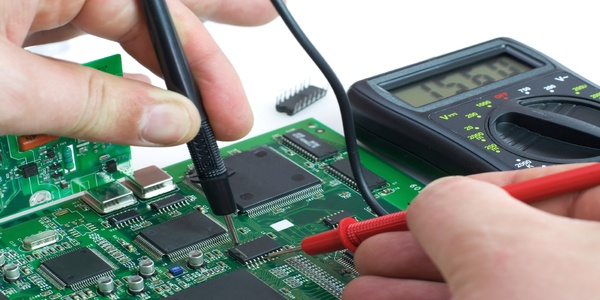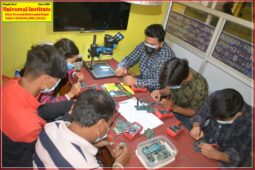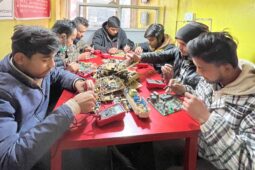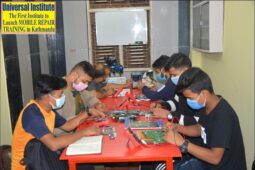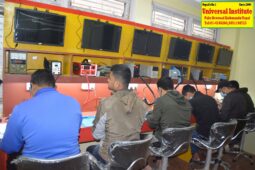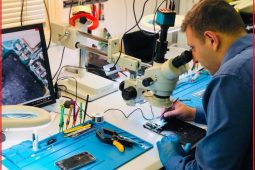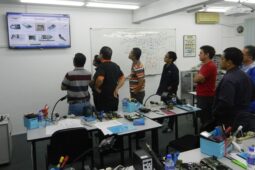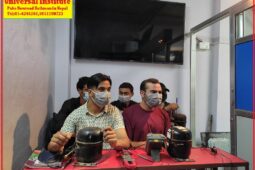Electronics Training Center In Kathmandu | Basic Electronics Training
Universal Institute has been providing the electronics training for a long time with the aim to fulfill the need of expert technicians in the field of electronics. The institute provides much practical training than theoretical knowledge with regular lab practices.
This electronics training institute has been producing technicians who can really work in the field and seeks help from many expert technicians who have worked and gained experience in the field of electronics. The institute is able to provide the services and training in electronic product design, testing, and repairs to the trainees who want to carry their career in electronics.
INTRODUCTION
This course is tailored to individuals who are new or have some experience in the electronics field. There is no prerequisite eligibility are required, so almost any student that is not from technical background can easily join this Basic Electronics Repairing course.
TARGET GROUP
The Basic Electronics course is targeted at SEE school leavers, Technical College Students, Technicians, Retirees, Electronic Hobbyists and those who are interested in Electronics Repair.
COURSE OBJECTIVES
At the end of the course, participants will be able to:
- Know the safety precautions when troubleshooting electronic equipment.
- Assemble and dissemble electronics devices.
- Use an analog and digital multimeter to measure voltage, current and resistance for troubleshooting purposes.
- Differentiate between AC/DC circuit and ampere.
- Remove and solder electronic components from and onto PCB board.
- Identify and measure most of the basic electronic components so that you can start to troubleshoot any type of electronics equipment.
- Build own electronics project kits.
Benefits offered
Long term technical support by UNIVERSAL through email and Whatsapp. You will never be left alone after the course. any electronics repair questions just call, email or Whatsapp us.
Click below to watch the pcb repair training video.
Basic Electronics Course in Kathmandu
In this course you will learn the basics in Electrical Training that include- electricity, conductor, insulator, voltage, current, resistance, P.D., and inter-relation between Voltage, Current, and Resistance etc, Explaining the difference between AC & DC, Describing the purpose of Earthing and Types of Earthing. The successful candidate will be now able to take precautions in any electrical hazards.The basic electronics training course is provided to the trainees in each and every program available in the training institute.
The trainees will be able to tackle the problems related to the electronics after the completion of the basic electronics training course and are placed in many industries of electronics as technicians. The courses are designed as per the latest technology in electronics to enhance the quality of electronics training in the country.
This basic electronics training center in Kathmandu has expert trainers who can facilitate the trainees with their experiences and knowledge about the electronics. They provide the required study documents like notes, slides and other major lab practices to the trainees so that there won’t be any problem of teaching and learning.
The major equipment available in this basic electronics training center in Kathmandu are microprocessor trainer kit, microcontroller trainer kit, digital troubleshooting kit, microprocessor-based data acquisition kit, universal programmer and tester, DC regulated power supplies, multimeters, and RF&AF single generators. The institute is always fulfilling the requirements of the trainees who want to be the future technicians in the industry and has been established as one of the major electronics training centers in Kathmandu.
- Understand basic concepts like voltage, current, power, watt,heat and etc
- Understand working principle of the most important electronic components.
- Identify schematic symbols and simple schematic diagrams
- Design basic circuits in a simulation environment
- Learn Electronics By Building Circuits From Circuit Diagrams
Practical Use OF Tools
- Soldering Iron Use
- Use Of Multimeter
- SMD Machine Use
- Practical tools info
- Use De-soldering Wire
- Use Jumper Wire
- Soldering in I.C
- Build Circuits Using Integrated Circuits
- Design Your Own Circuit Board
What is a basic electronics course?
The course is about basic electronic circuits, both analog and digital. In the analog part, Resistor, semiconductor circuits, Op Amp circuits will be covered. In the digital part, combinatorial and sequential circuits will be covered.
- Digital electronics
- Analogue electronics
- Circuit design
- Integrated circuits
- Power electronics
- Optoelectronics
- Semiconductor devices
Benefits of attending basic electronics courses
- Opportunity to work in the electronics industries.
- Reduce maintenance breakdown cost.
- Learn additional skill to lead you to a promotion.
- Start your own electronics repairing business.
- Pathway to further your studies.
- You will get to see some of the latest repair test equipment in the market.
Basic electronics course syllabus (Course Contain)
1.Basic Electricity
a) Ohm’s Law
b) Kirchoff’s Laws
c) Faraday’s Laws of Induction
2.Anaiogue/Digital System (Basic Principle & Properties)
a) Binary, Decimal & Hexadecimal System &It’s Conversion
b) Analogue to Digital Conversion
c) Digital to Analogue Conversion
d) Different Types of Gates & Flip-Flop
e) De-Morgan’s theorem
3. Communication System
3.1. Propagation of Radio Wave
a) Direct wave
b) Guround wave
c) SKy wave
d) Relation Between lonosphere & HF
3.2. Broadcast Antenna System
a) Propagation, Polarization, Antenna gain , Impendence, directivity,etficiency, EMW
b) Different types of Antenna
c).Fading & Diversity
d) Transmission Lancs & Characteristics
3.3 Radio Receivers & Transmitters
a) AM/FM Transmite
b) Stages and it’s Functionns
3.4 Basic Principles of Wire & Wireless Communations systems
a) Transmission Method:-Wire/ cable, Fiber optics, Microwave
b) Transmission links:- HF,VHE,UHF wire less and Satellite Communations
c) Basic principle & stage of Television
3.5 B.E Sound System
a) Microphone
b) loudspeaker
4. Básic Electronics
a) Resistor, construction, types, characteristics, color code.
b) Capacitors, construction, types, characteristics, color code.
c) Semi conductor diodes:- PN Junction, depletion layer
forward & reverse bias, Zener diode &
lightemitting diode, varactor diodes, photo diodes, characteristics &
Applications
d) Rectifier circuits
e) Types of Transistors, working principles & it’ s Applications
f),Power transistor characteristics & Applications.
g),Photo transistor characteristics & Applications.
h) Oscillators circuit.
5. Computer Fundamentals
a) Basic computer Principles.
b) Input out put & memory organization .
c) Computer hard ware/ sottware.
d) computer network & system.
h) Internet & It’s applications .
6. Power Supply System
a) Main & stand by pe0wer suppiy system in broad casting.
b) Uninterrnuptile power Suppy system
c) Transtormer & lts types.
d) Battery,constructton & types
e) Principies of solar system.
Basic Electronics Course Near me
The institute is providing the basic electronics training and consultancy for electronic industry, selection of electronic equipment, facility design, process modification & design of electronic systems. This institute has been providing the basic electronics training in Nepal and many trainees are now working as technicians in the field of electronics.After the completion of the electronics training course in this institute, the certificates are provided to each and every trainee so that it will be easy for them to apply for the post of electronics technicians in many companies. The certified trainees are the qualified trainees for the job of electronics technicians in different companies.
Universal Institute conducts regular training programs and workshops on different topics for the betterment of the institute and its clients. This electronics training institute is now a leading institute in the field of electronics training and has proved to be the best institute for producing the expert technicians. So, enroll now in this electronics training institute if you like to work as electronics technicians.
We practice you, to be a professional in repairing all kind of electronics devices. This course teaches you step-by-step how to repair all kind of electronics devices. The advantage of our program is, you will be able to start your own repair and maintain electronic equipment repair center after completing of our course. The duties of an electronics repair technician revolve around working to repair electronic equipment in a variety of different settings. In addition to repair, in this career, you may work on the calibration of equipment, or you may perform tests to assess the performance of an electronic device and replace a component if necessary.
These professionals can work with a variety of equipment types, including electric vehicle and transportation equipment, commercial equipment, power stations,home appliance equipment and industrial equipment.
Digital Electronics | Advance Electronics
The digital electronic systems may be defined as the circuits that process information in a coded format. Their application domains are really large and nowadays one can find a digital electronic systems module in every electronic system. There are different ways to process information and numerous alternatives for implementing digital electronic systems, the election is not a trivial issue and it depends on the application and user requirements. The Digital Electronic Systems will provide students the assimilation of methods and strategies for analyzing and designing microcontroller based systems.This course is related to Basic Electronics (Analogue Electronics) and Digital Electronics .
The Digital Electronics Training in Kathmandu
Topics :
- Number System
- Boolean Algebra and Logic Gates
- Gate Level Minimization
- Combinational Logic Circuits
- Flip-Flops and Sequential Circuits
- Register and Counters
- Memory and Programmable Logic
Part one: Number System
- Program for Binary To Decimal Conversion
- Program for Decimal to Binary Conversion
- Program for decimal to octal conversion
- Program for octal to decimal conversion
- Program for hexadecimal to decimal
Part Two: Algebra
- Properties of Boolean algebra
- Representation of Boolean Functions
- Canonical and Standard Form
- Functional Completeness
- Logic Gates
Part Three: Logic Circuits :
- Half-Adder
- Half-Subtractor
- Half-Adder and Half-Subtractor using NAND NOR Gates
- Full-Adder
- Full Subtractor
- Code Converters – BCD(8421) to/from Excess-3
- Code Converters – Binary to/from Gray Code
- Code Converters – BCD to 7 Segment Decoder
- Parallel Adder & Parallel Subtractor
- Carry Look-Ahead Adder
- Magnitude Comparator
- BCD Adder
- Encoders and Decoders
- Encoder
- Binary Decoder
- Combinational circuits using Decoder
- Multiplexers
Part Four: Register and Counters :
- Counters
- Design counter for given sequence
- n-bit Johnson Counter
- Amortized analysis for increment in counter
- Ripple Counter
- Digital Logic | Ring Counter
- Shift Registers
- Design 101 sequence detector
- Universal Shift Register
- RTL (Register Transfer Level) design vs Sequential logic design
- Verilog Data Types
Part Five: Memory and Programmable Logic :
- Read-Only Memory (ROM) | Classification and Programming
- Programmable Logic Array
- Programming Array Logic
- RAM vs ROM
- Operational Amplifier (op-amp)
What is a Power Supply? | SMPS Power Supply Training in Kathmandu
The power supply is the essential parts in every electronics system. Its circuit is used in various electrical & electronic devices. The main function of this power supply to change the electrical current from a source to the accurate voltage, frequency and current to supply the load. Sometimes, these power supplies can be named to as AC TO DC power converters. In this article, we look into the definition of a different types of power supplies and how they work.
- Variable Power Supply
Its power supplies are designed using transformers or adjustable autotransformers. Step down transformers convert AC-to-AC voltage levels. A transformer with multiple (primary n secondary)windings or taps may be used to design such power supply otherwise adjustable autotransformer can be used.
- Linear Regulated Power Supply
Its Linear regulated power supplies are AC-to-DC converter n regulator power supplies. These are the same as unregulated input power supplies except that they use a transistor circuit operating in an active or linear region in place of bleeding resistor.There are several voltage-regulator(oscillator)ICs available that have an active transistor circuit integrated within them.
- Adjustable Regulated Power Supplies
Adjustable voltages by using a variable resistor at the end-stage. The variable resistor can drop the output voltage to adjustable values. Such an adjustable power supply can then supply voltages in the range from 0 to 100 voltage regulated by the supply.
- SMPS Power Supply
A switch mode power supply (SMPS) is a type of power supply that uses Transister switching techniques, rather than standard linear methods to provide the required output voltage. The basic switching circuit converter consists of a power switching stage and a control circuit. The power switching stage performs the power conversion from the circuits input voltage to its output voltage which includes output filtering.
Module 1
Introduction to SMPS
1. Introduction to Switch Mode Power Supplies (SMPS)
2. Identifying Electronic Components in Different Types of SMPS .
3. Block Diagram of a Typical SMPS and How It Works
4. Easy Way To Understand The 11 Circuit Functions of SMPS With The Help Of Schematic Diagrams
5. Input Protection and EMI Filtering and Bridge CircuitCircuit
6. Start Up and Run DC Circuit
7. Oscillator Circuit
8. Secondary Output Voltage Circuit
9. Error Detection Circuit
10.Feedback Circuit
11. Protection Circuit
12. Power Factor Correction (PFC) Circuit
Module 2
Secrets of SMPS Troubleshooting Techniques
- Safety Guidelines
- Understand The Six Common Problems Found In SMPS
- No Power
- Low Output Voltage
- High Output Voltage
- Power Cycling/Pulsating/Blinking
- Power Shutdown
- Intermittent Power Problem
- How to Easily Perform Voltage Testing On SMPS Circuit
- How to Use Oscilloscope to Test SMPS Circuit Waveforms
- Find Out How Useful Is The Series Light Bulb Trick In SMPS
Module 3
Repairing Method
- Using the Blue Ring Tester Method
- Flickering Method
- Resistance Test Method
- Isolation Method
- Secondary Diode Removal Method
- Simple Way For Beginners To Troubleshoot And Repair Any
Trainer’s Profile
Er.D.P. Tiwari
Graduated with a bachelor degree of electronics and communication engineering from Delhi University, Delhi, India. He also holds Certificates in area of Industrial Automation Electronics, Micro-computer and Radio Engineering. He has over 21+ years of technical experience in the area of electronics and communication engineering field as he worked in Universal electronics institute where he was involved in troubleshooting and repairing in Consumer Electronics.He also repair Mobile phone,Laptop Motherboards , Smart tvs, selling test equipment (Cell phone,laptop,TVs repair tools) and written six technical troubleshooting repair books/e-books to cater for electronics repairers worldwide.
When he started providing technical training in the year 2000, besides training he also involved in Research & Development of desktop-laptop PC Motherboards and TVs Mainboards repair techniques to share with training students in many different type of electronics industries (Consumer, Industrial, Medical, Telecommunications and ..etc).
Related Posts:
- Mobile Repair (Advance Chip Level)
- Computer/Laptop repair (Advance Chip Level)
- Advance Mobile Software (Full)
- TV(LCD/LED/Smart) Repair Course
- Basic Electronics & PWR Supply Course 45 days
- eMMC/UFS/Nand Training 30 days
- AC & Fridge Repair Training 60 days
- Washing Machine Repair Course-30 days
- Building Electricians(House wiring) 45 days
- CCTV Camera Opearting & Installation 45 days
- Home Appliances Repair Training 45 days
- Printer Repair (Dot-Matrix, Ink-Jak, Laser)
- Hobby Electronics Projects 45 days
- Drone Assembling Course 15 days
- Laptop Repair (Basic Card Level-1)
